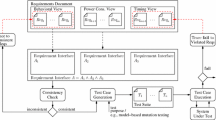Abstract
This paper introduces a model-based approach for minimization of test sets to validate the interaction of human-computer systems. The novelty of the approach is twofold: (i) Test cases generated and selected holistically cover both the behavioral model and the complementary, fault model of the system under test (SUT). (ii) Methods known from state-based conformance testing and graph theory are extended to construct efficient, heuristic search-based algorithms for minimizing the test sets that are constructed in step (i), considering also structural features. Experience shows that the approach can help to considerably save test costs, up to 60%
Similar content being viewed by others
References
Zhu H, Hall PAV, May JHR (1997) Software unit test coverage and adequacy. ACM Comput Surv 29(4):336–427
Belli F (2001) Finite-state testing and analysis of graphical user interfaces. In: Proc 12th int symp on softw reliability eng (ISSRE), pp 34–43
Chow TS (1978) Testing software designed modeled by finite-state machines. IEEE Trans Softw Eng 4:178–187
Aho AV, Dahbura AT, Lee D, Uyar MÜ, (1991) An optimization technique for protocol conformance test generation based on UIO sequences and rural chinese postman tours. IEEE Trans Commun 39:1604–1615
Offutt J, Shaoying L, Abdurazik A, Ammann P (2003) Generating test data from state-based specifications. J Softw Testing, Verification Reliability 13(1):25–53
Parnas DL (1969) On the use of transition diagrams in the design of user interface for an interactive computer system. In: Proc. 24th ACM Nat’l conf. pp 379–385
Shehady RK, Siewiorek DP (1997) A method to automate user interface testing using finite state machines. In: Proc. int. symp. fault-tolerant comp. FTCS-27, pp 80–88
Tai K, Lei Y (2002) A test generation strategy for pairwise testing. IEEE Trans On Softw Eng 28(1):109–111
DeMillo RA, Lipton RJ, Sayward FG (1978) Hints on test data selection: help for the practicing programmer. IEEE Computer 11(4):34–41
Delamaro ME, Maldonado JC, Mathur A (2001) Interface mutation: an approach for integration testing. IEEE Trans Softw Eng 27(3):228–247
Bochmann GV, Petrenko A (1994) Protocol testing: review of methods and relevance for software testing. In: Proc. of the 1994 ACM SIGSOFT Intl Symp on Softw Testing and Analysis, ACM Press, pp 109–124.
Blanke M, Kinnaert M, Junze J, Staroswiecki M, Schroder J (eds.) (2003) Diagnosis and fault-tolerant control. Springer
Hamscher W, Console L, de Kleer J (1992) Readings in model-based diagnosis. Morgan Kaufmann
Russell S, Norvig P (1995) Artificial intelligence. A Modern Approach, Prentice Hall
Memon AM, Pollack ME, Soffa ML (2000) Plan generation for GUI testing. In: Proc. 5th intl conf on artificial intelligence planning and scheduling. AAAI Press, pp 226–235
Memon AM, Pollack ME, Soffa ML (2001) Hierarchical GUI test case generation using automated planning. IEEE Trans Softw Eng 27(2):144–155
Jones BF, Eyres DE, Sthamer H-H (1998) A strategy for using genetic algorithms to automate branch and fault-based testing. Computer J 41(2):98–107
Marré M, Bertolino A (2003) Using spanning sets for coverage testing. IEEE Trans Softw Eng 29(11):974–984
West DB (1996) Introduction to graph theory. Prentice Hall
IEEE Std 610.12 (1990) IEEE Standard Glossary of Software Engineering Terminology
Gaudel M (1995) Testing can be formal, too. In: Proc intl conf on theory and practice of software development (TAPSOFT) vol 915. LNCS, pp 82–96
Koufareva I, Petrenko A, Yevtushenko N (1999) Test generation driven by user-defined fault models. In: Proc. of 12th intl. workshop on testing of communication systems (IWTCS). Hungary, pp. 215–233
Thimbleby H (2003) The directed chinese postman problem. School of Computing Science, Middlesex University, London
Dijkstra EW (1959) A note on two problems in connexion with graphs. J Numerische Mathematik 1:269–271
Belli F, Nissanke N, Budnik Ch J (2004) A holistic, event-based approach to modeling, analysis and testing of system vulnerabilities. Technical Report TR 2004/7, Univ. Paderborn
Goodenough JB (1975) Exception handling—issues and a proposed notation. Commun ACM 18(12):683–696
Author information
Authors and Affiliations
Corresponding author
Additional information
Fevzi Belli received the M.S., Ph.D., and Habilitation degrees in electrical engineering and computer science from the Berlin Technical University. He is presently a Professor of Software Engineering in the Faculty of Computer Science, Electrical Engineering and Mathematics, University of Paderborn, Paderborn, Germany. Prior to this, he headed several projects at a software house in Munich, was a Professor of Computing Science at the Hochschule Bremerhaven and a faculty member of the University of Maryland, European Division. He chaired several international conferences, e.g., ISSRE 1998 and is author and co-author of more than 100 papers published in scientific journals and conference proceedings. His research interests are in testing/fault tolerance/reliability of software and programming techniques.
Christof J. Budnik received the MS degree in electrical engineering and computer science in 2001 from the University of Paderborn. In 2002, he joined the Department of Computer Science, Electrical Engineering and Mathematics at the same University where he is currently a faculty member. His research interests are in the areas of software quality, testing of interactive systems and safety-critical user interfaces.
Rights and permissions
About this article
Cite this article
Belli, F., Budnik, C.J. Test minimization for human-computer interaction. Appl Intell 26, 161–174 (2007). https://doi.org/10.1007/s10489-006-0008-0
Published:
Issue Date:
DOI: https://doi.org/10.1007/s10489-006-0008-0




